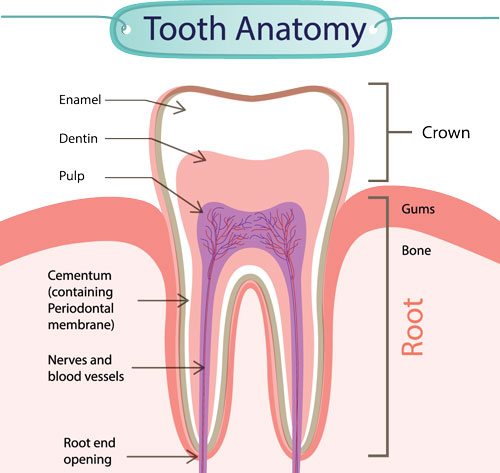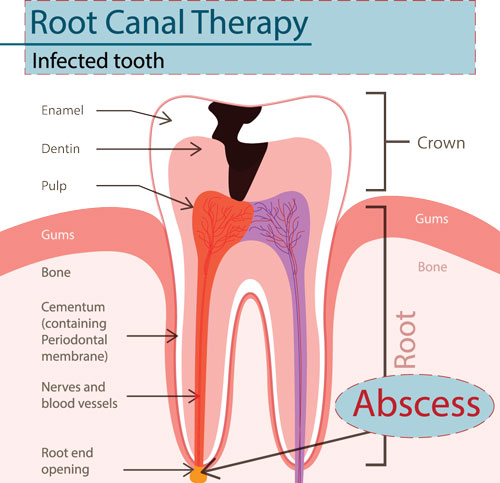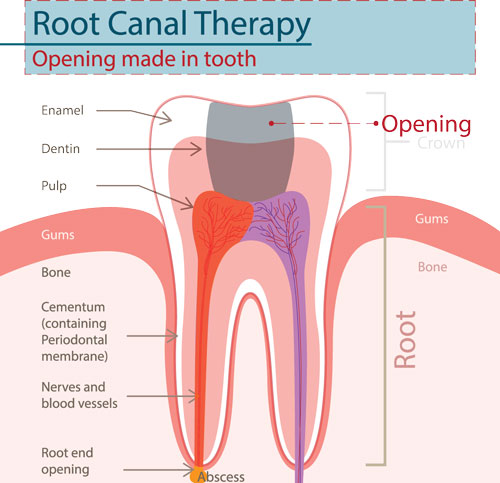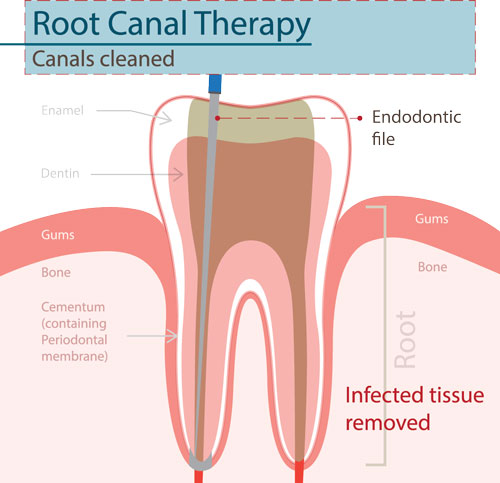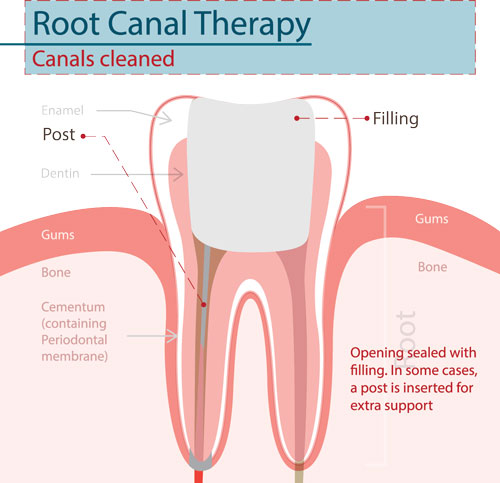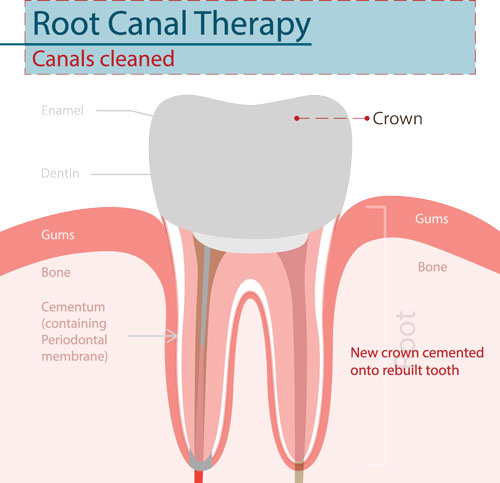What is Endodontics?
Endodontic treatment refers to a number of procedures aimed at treating an inflamed or infected dental pulp. The most common endodontic procedure is root canal treatment.
The dental pulp is a tissue consisting of many vital cells, blood vessels and nerves. Every healthy tooth contains a dental pulp within it that extends into the roots through small canals known as ‘root canals’. The pulp nourishes the tooth from within and keeps it ‘alive’. The tooth is also nourished from the outside by the surrounding periodontal ligament and bone.
Why does a pulp become diseased?
The dental pulp can become inflamed and infected if bacteria enters the pulp. This can be through decay, leaking old fillings or cracks which can occur as a result of fractures, wear or traumatic injuries.
Root canal treatment is a procedure in which the diseased dental pulp is removed, the root canals slightly enlarged (preparation), disinfected thoroughly and sealed (obturation).
What does root canal treatment involve?
Root canal treatment is usually performed under local anaesthetic. The tooth is isolated using a plastic sheet known as a rubber dam which keeps the working environment clean and prevents fluid build-up in the patient’s mouth, making the treatment a more comfortable experience. The dental pulp is removed, and the canals prepared using small files with constant irrigation and disinfection of the root canal system throughout the procedure. Once the canals have been disinfected thoroughly, they are sealed with a rubber like material known as Gutta Percha embedded in antibacterial sealing paste. The treatment may be done in one visit but in some cases may require two or more visits. There will be a small number of x-rays taken throughout the procedure to ensure adequate filling of the canals.
Root canal treatment is usually performed under local anaesthetic. The tooth is isolated using a plastic sheet known as a rubber dam which keeps the working environment clean and prevents fluid build-up in the patient’s mouth, making the treatment a more comfortable experience. The dental pulp is removed, and the canals prepared using small files with constant irrigation and disinfection of the root canal system throughout the procedure. Once the canals have been disinfected thoroughly, they are sealed with a rubber like material known as Gutta Percha embedded in antibacterial sealing paste. The treatment may be done in one visit but in some cases may require two or more visits. There will be a small number of x-rays taken throughout the procedure to ensure adequate filling of the canals.
There is a common misconception that root canal treatment is painful. Most of our patients are pleasantly surprised that root canal treatment is actually completely painless in the strong majority of cases, if performed properly by an expert under the appropriate analgesia.
Root canal treatment is a complex procedure which if performed inadequately can lead to the reinfection of the tooth and failure of treatment in a relatively short space of time. However properly performed root canal treatments using specialist techniques, equipment and materials are shown to have very good long-term success rates and if looked after well can often last for a lifetime. In the case of posterior (back) teeth it is essential that the root canal treated tooth is restored with a laboratory manufactured crown or onlay after the root canal treatment is complete to ensure the best long-term survival.
If a root canal treatment fails and the tooth becomes re-infected it is often possible to enter and clean the canals again in a procedure known as root canal re-treatment. In cases with persisting disease such as cysts it is also possible to carry out a small micro-surgical procedure known as ‘apical micro-surgery’ to the root end of the tooth to remove the infection directly at its source.
In some cases, for example if the root of the tooth becomes cracked or if there is inadequate tooth structure remaining endodontic treatment may not be possible.
The alternative to root canal treatment is usually extraction of the tooth. Replacing the gap is possible by a denture (a removable appliance), a bridge (a fixed appliance that is fitted by cutting and bonding to adjacent teeth) or a dental implant. Dental implants are generally considered to be the gold standard for replacing a missing tooth however there is no better alternative than maintaining your own teeth in function, nourished by the healthy surrounding bone and periodontal tissues.
There has been significant media coverage on this topic recently much of which unfortunately has no credible scientific basis. There is some evidence that infected root canal treated teeth can be associated with certain medical conditions such as heart disease. However, this is also true of gum disease and other inflammatory diseases in the body. However, there is NO evidence that successfully root canal treated and healthy teeth with uninflamed surrounding tissues are linked to any medical health condition whatsoever. If you have any concerns regarding your root canal treated tooth see your dentist who can assess and if necessary, refer you to a specialist to re-treat an infected tooth and return it to a healthy state.
The following images can be used to explain the RCT procedure:
